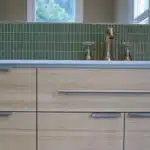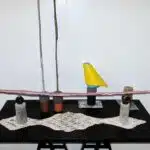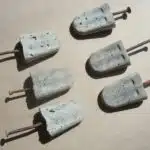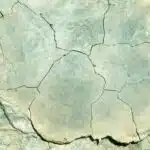Concrete vanity tops are a popular choice for homeowners who want to add an industrial and modern touch to their bathrooms. While they may seem like a daunting DIY project, with the right tools and techniques, pouring your own concrete vanity top can be a rewarding and cost-effective endeavor.
Before beginning the process of pouring a concrete vanity top, it is important to understand the necessary steps involved. From choosing the right materials to properly preparing the surface and mixing the concrete, each step requires precision and attention to detail. By following this guide, novice masons can successfully create a beautiful and durable concrete vanity top that will serve as a functional centerpiece for their bathroom.
Gathering The Necessary Tools And Materials
According to recent statistics, concrete is the most widely used building material in the world. This is due to its strength, durability, and versatility. It’s no wonder that concrete vanity tops are becoming increasingly popular. Before beginning your project, it’s essential to gather all the necessary tools and materials.
Choosing the right concrete mix is crucial for achieving a smooth and polished finish on your vanity top. There are many types of concrete mixes available on the market, each with its unique properties. For this project, you’ll need a high-strength mix that is specifically designed for countertops. These mixes typically contain additives such as fiber reinforcement or superplasticizers to increase strength and workability.
Finding affordable materials is also important when pouring a concrete vanity top. While it may be tempting to purchase expensive materials, it’s possible to create a beautiful and functional vanity top without breaking the bank. Consider using reclaimed wood for the base instead of purchasing new lumber or using pre-made molds instead of buying expensive forms. By being resourceful and creative in your material choices, you can save money while still achieving a professional-looking result.
Once you’ve gathered all the necessary tools and materials, it’s time to start measuring and cutting the wood base for your vanity top.
Measuring And Cutting The Wood Base
Wood selection is a crucial part of creating a sturdy base for your concrete vanity top. The base should be made of high-quality wood, such as plywood or MDF, that can withstand the weight of the concrete and any additional fixtures. The thickness of the wood depends on the size and weight of your vanity top. A thicker base may be necessary for larger tops or if you plan to install heavy sinks.
When it comes to cutting techniques, precision is key. Before cutting the wood, it’s important to measure the dimensions of your vanity top carefully. Use a straight edge and a pencil to mark your measurements on the wood before cutting. A circular saw or jigsaw can be used to cut the wood according to your measurements. Be sure to wear protective gear such as eye goggles and gloves during this process.
Once you’ve cut your wood base, you can move on to creating a template for your vanity top. This template will serve as a guide for pouring and shaping the concrete mix onto the base. Begin by covering the entire surface of the wood with plastic wrap or a release agent spray to prevent sticking. Then, using cardboard or other flexible material, trace out the shape of your desired vanity top onto the plastic wrap or release agent. This template will help ensure that your concrete mix fits perfectly onto your base and creates a smooth finish without any gaps or rough edges.
Creating A Template For The Vanity Top
To create a template for the vanity top, you will need to follow a precise process. Firstly, determine the dimensions of the countertop based on the size of your bathroom and any pre-existing cabinetry. Then, use a large piece of cardboard or plywood to create an outline of the countertop’s shape. Carefully measure all angles and curves to ensure that your template is accurate.
Once you have created your template, it’s time to design the edges. This is where you can get creative and add personality to your vanity top. Choose from a variety of edge designs such as bullnose or beveled, depending on your personal taste and bathroom décor. By taking extra care in this step, you can elevate the look of your concrete vanity top from ordinary to extraordinary.
To achieve a cohesive aesthetic for your bathroom, it’s essential to choose the right color mix for your concrete vanity top. Consider factors such as lighting, wall color, and flooring when selecting a color palette for your countertop. A professional concrete masonry expert can help guide you in choosing the perfect shade of concrete that complements your overall bathroom design.
When designing a concrete vanity top, every detail counts. Creating an accurate template ensures that you have precise measurements for cutting and shaping the concrete slab. Additionally, carefully choosing edge designs and color mixes adds visual interest and elevates the overall look of the finished product. In the following section about preparing the work area, we will discuss how to properly set up your workspace for pouring and finishing the concrete slab.
Preparing The Work Area
To begin preparing the work area for pouring a concrete vanity top, it is essential to wear protective gear. Concrete dust and debris can be hazardous to your health, so ensure you have a respirator mask, safety goggles, and gloves. It is also important to cover any exposed skin to prevent irritation or chemical burns. Take the time to inspect your gear and replace any damaged or worn-out equipment before starting.
Once you are wearing the proper protective gear, you must clean the work area thoroughly. Remove any items that may get in the way during the process and sweep the floor clear of debris. Use cleaning supplies such as soap, water, and disinfectant to sanitize surfaces where concrete will be poured. Properly cleaning the area will ensure that no foreign objects or substances interfere with the curing process of your concrete vanity top.
Lastly, it is important to organize your tools and materials before moving onto applying release agent to the wood base. Store all materials in an easily accessible location while keeping them off of the ground and away from potential hazards like water or direct sunlight. Ensure that all tools are clean and in good condition before use; this will help prevent mistakes that could potentially ruin your project. With a well-organized work area, you can move onto applying release agent with confidence knowing that everything is within reach when needed.
Applying Release Agent To The Wood Base
To achieve a seamless and polished look for your concrete vanity top, it is essential to apply release agent to the wooden base before pouring the concrete. This technique ensures that the concrete will not stick to the wood during curing and prevents any potential damage to the wood surface or edges.
Applying release agent may seem like a simple task, but it requires proper techniques to ensure that you achieve a smooth finish. One common mistake is using too much release agent, which can cause discoloration of the concrete or create an uneven surface. Another mistake is not applying enough release agent, which can cause the concrete to stick to the wood, leading to cracks and other damages.
To apply release agent correctly, start by cleaning the wooden base of any debris or dust. Next, use a paintbrush or sprayer to evenly coat the wooden base with release agent. It is important not to oversaturate the wood with too much spray as this can lead to uneven surfaces. Allow 24 hours for the release agent to dry before pouring your concrete mixture onto the base.
As you prepare your wooden base for pouring, keep in mind that applying release agent is just one step towards achieving a perfect vanity top. Avoiding common mistakes such as using too little or too much release agent will help you create a beautiful and functional addition to your bathroom. The next step in creating your concrete vanity top involves mixing the concrete mixture thoroughly before pouring it onto your prepared wooden base.
Mixing The Concrete
After applying the release agent, it’s time to mix the concrete. Achieving the right consistency is crucial for a concrete vanity top that is both durable and aesthetically pleasing. The ideal consistency should be similar to that of pudding, not too thick or too thin.
Mixing techniques also play a significant role in ensuring the success of your project. One popular technique is hand mixing, which involves using a hoe or shovel to mix the concrete manually. However, this method can be labor-intensive and time-consuming. Alternatively, using a small cement mixer can save time and effort while producing consistent results.
To ensure proper mixing, start by adding water to your mixer, followed by half of the required amount of concrete mix. Mix well before gradually adding the remaining concrete mix until you achieve the desired consistency. Once mixed, cover the mixer with plastic sheeting to prevent premature drying.
- Use clean tools when mixing concrete
- Gradually add water to avoid over-saturating
- Consider using admixtures such as fibers or colorants
- Follow manufacturer instructions for curing times
Now that you have achieved optimal concrete consistency and selected your preferred mixing technique, you are ready to pour your vanity top! But first, make sure you have all necessary tools and protective gear on hand before beginning this next step in creating a beautiful and long-lasting concrete vanity top for your home or business.
Pouring The Concrete
Before pouring the concrete for your vanity top, it is essential to ensure that the concrete consistency is correct. The ideal consistency of concrete should be similar to that of a thick milkshake. If the mixture is too thick or too runny, it may lead to problems during the pouring process. You can test the consistency by inserting a shovel into the mixture and pulling it back out. If the mixture stays on the shovel without running off, then it’s ready.
When you’re ready to pour the concrete, make sure you have all your tools and equipment within reach. Pouring techniques play a significant role in ensuring that your vanity top comes out smooth and even. Start pouring at one end of the mold and work your way towards the other end while moving back and forth across its width. This technique helps to ensure that there are no air pockets or voids as you pour.
As you pour, use a trowel to spread out any lumps or bumps in the mixture. You may also need to use a vibrator tool to remove any trapped air bubbles in the concrete. Once you’ve finished pouring, let it settle for about 10 minutes before smoothing over with a trowel again. This will help you achieve an even surface for your vanity top before moving on to leveling the concrete in preparation for finishing touches.
Leveling The Concrete
Concrete leveling techniques are essential for achieving a smooth surface when pouring a vanity top. A level surface is necessary to ensure the vanity top is functional and aesthetically pleasing. Additionally, uneven surfaces can create stress points that can lead to cracking or other structural issues over time.
To begin the leveling process, use a long straight edge, such as a 4-foot level or a laser level, to check the flatness of the concrete surface. Identify any high spots or low spots that need to be addressed before proceeding with further steps. Use shims or self-leveling compound as needed to correct these spots.
Next, use a bull float or power trowel to level the surface of the concrete. This step involves moving the tool back and forth in broad arcs across the surface of the concrete to smooth out any bumps or dips. Keep in mind that overworking the concrete can cause it to become weak and prone to cracking, so it’s important not to spend too much time on this step.
Tips for achieving a smooth surface include working quickly but carefully and avoiding any sudden stops or starts while troweling. Additionally, using a slightly wetter mix can make it easier to spread and work with the concrete. Once you are satisfied with the levelness of the surface, allow it to dry completely before proceeding with further steps such as troweling the surface.
Troweling The Surface
After pouring the concrete vanity top, the next step is troweling the surface. Troweling is a finishing technique that helps to smooth out any rough spots or imperfections on the surface of the concrete. It is important to use a steel trowel for this process as it allows for greater control and precision.
To begin, start at one end of the vanity top and work your way towards the other end, using long, smooth strokes. Be sure to maintain a consistent pressure throughout the process to ensure an even finish. If you encounter any areas that are particularly rough or uneven, use a circular motion with your trowel to smooth them out.
Once you have finished troweling, allow the concrete to cure for at least 24 hours before moving on to any further finishing techniques. During this time, it is important to keep the surface moist by misting it with water regularly. This will prevent cracking and help ensure a strong, durable finish. After curing is complete, you can move on to sanding and sealing your new concrete vanity top. With proper maintenance and care, your new vanity top will provide years of beauty and functionality in your home.
As mentioned earlier, letting the concrete cure after troweling is crucial for achieving a strong, durable finish. During this time, it is important not to disturb or walk on the surface of the concrete until it has fully hardened. Once cured, you can move on to sanding down any rough spots or imperfections on the surface of your vanity top using progressively finer grits of sandpaper until you achieve a smooth finish. After sanding is complete, seal your new vanity top with an appropriate sealer according to manufacturer instructions for best results.
Letting The Concrete Cure
As the saying goes, patience is a virtue. This is particularly true when it comes to letting concrete cure. Once poured, the concrete must be allowed to dry and gain its full strength and durability before it can be used. Depending on the type of concrete mix used and other factors such as temperature and humidity levels, this process can take anywhere from a few days to several weeks.
There are two methods for curing concrete: wet curing and dry curing. Wet curing involves keeping the surface of the concrete moist by covering it with a damp cloth or plastic sheeting. This helps to prevent the surface from drying out too quickly, which can lead to cracking and other damage. Dry curing involves allowing the concrete to air-dry naturally without any additional moisture.
In addition to proper curing, reinforcing options should also be considered when pouring a concrete vanity top. Reinforcing materials such as steel rebar or wire mesh can be added to help improve the strength and stability of the finished product. Your choice of reinforcing material will depend on various factors including the size and weight of your vanity top, as well as any additional stresses that may be placed on it over time.
When it comes to pouring a successful concrete vanity top, proper curing techniques are key. Whether you choose wet or dry curing methods, taking adequate time for this step will ensure that your finished product is strong and durable for years to come. Additionally, incorporating appropriate reinforcing materials will provide extra peace of mind knowing that your vanity top is built to last. Next up in our process, we’ll move onto sanding and sealing the surface for an even smoother finish.
Sanding And Sealing The Surface
After allowing the concrete to cure for at least 24-48 hours, it’s time to move on to sanding and sealing the surface. The curing process is crucial as it ensures that the concrete is strong enough and ready for further processing. During this period, make sure to keep the concrete moist by covering it with plastic sheeting or a damp cloth.
Choosing the right sealant is essential for ensuring that your vanity top remains in good condition for years to come. There are several types of sealants available in the market, including acrylics, epoxies, and polyurethanes. Each has its unique properties and benefits, so make sure to choose one that best suits your needs.
Proper sanding techniques are crucial for achieving a smooth and polished finish on your concrete vanity top. Start with coarse grit sandpaper (around 80 grit) and gradually work your way up to finer grits (up to 400 grit). Be sure to use a vacuum or dust extractor while sanding to avoid inhaling harmful dust particles. Once you have achieved a smooth surface, wipe down any remaining dust before applying the sealant.
As you complete the final stages of preparing your concrete vanity top, it’s important to remember that attention to detail is key. Take your time when choosing a sealant and be sure to follow proper sanding techniques for achieving a beautiful finish on your project. With these steps completed, you’re now ready to move on to installing your new vanity top with confidence and pride.
Installing The Vanity Top
Before installing the vanity top, it is important to ensure that the base cabinets are sturdy and leveled. Otherwise, the top may crack or break under pressure. As a concrete masonry expert, I cannot stress enough how crucial it is to have a solid foundation. Imagine placing a delicate flower vase on a wobbly table; disaster waiting to happen.
Once you have confirmed that your base cabinets are in good condition, proceed with securing brackets on the underside of the top. This will ensure that it stays in place and does not shift over time. When selecting brackets, make sure they are strong enough to support the weight of your concrete vanity top. Choosing faucets is also an essential step in this process as they need to be installed before placing the top on the cabinets.
After securing brackets and choosing faucets, carefully place the concrete vanity top onto the base cabinets. Make sure it is centered and level before proceeding with any additional steps. In our next section, we will discuss adding finishing touches to your newly installed concrete vanity top that will elevate its appearance and functionality.
Adding Finishing Touches
After successfully installing the concrete vanity top, it is time to move on to adding those finishing touches. Before doing so, it is important to ensure that the concrete has properly cured. This process can take anywhere from a few days to a week depending on the type of concrete used and environmental conditions. It is crucial to allow enough time for curing as attempting to add finishing touches too soon can damage the surface.
Choosing hardware for your vanity top is an important step in completing the look of your bathroom. Selecting hardware that matches the style and finish of your faucet and other fixtures can bring together a cohesive design. Some popular options for vanity top hardware include drawer pulls, knobs, and towel bars. When selecting hardware, consider not only its appearance but also its durability and functionality.
Adding decorative elements such as plants or framed artwork can elevate the overall aesthetic of your bathroom. However, it is important to keep in mind that moisture levels in bathrooms can be high which may affect certain materials like wood or paper. Consider using moisture-resistant materials when adding decorative elements to your bathroom.
- Seal your concrete vanity top periodically with a high-quality sealant.
- Use neutral pH cleaners specifically designed for cleaning concrete surfaces.
- Avoid using abrasive cleaners or tools that could scratch or damage the surface.
- Wipe up spills immediately to prevent staining.
Maintaining your concrete vanity top is essential to prolonging its lifespan and preserving its appearance. By following these maintenance tips, you can keep your vanity top looking beautiful for years to come.
Maintaining Your Concrete Vanity Top
After pouring your concrete vanity top, you will want to ensure that it remains in pristine condition for as long as possible. With proper maintenance, your vanity top can last for years without needing any major repairs. The key is to stay on top of regular cleaning and stain removal.
Cleaning tips for your concrete vanity top include using a mild soap and water solution to wipe down the surface regularly. Avoid harsh chemicals or abrasive cleaners that can damage the finish. For tougher stains, try using a mixture of baking soda and water or vinegar and water to gently scrub the area clean. Remember to always rinse thoroughly with clean water after cleaning.
Stain removal can be a challenge with concrete surfaces, but there are several techniques that can be effective. For oil-based stains, try using a poultice made from baking soda and water or cornstarch and water. For rust stains, use a commercial rust remover specifically designed for use on concrete surfaces. Always follow the manufacturer’s instructions carefully when using any type of stain remover on your vanity top. By following these simple cleaning and stain removal tips, you can keep your concrete vanity top looking like new for years to come.
Looking after your concrete vanity top requires consistency and dedication in order to maintain its durability and aesthetic appeal. However, even with regular maintenance, issues may arise that require troubleshooting. In the next section, we will discuss common issues that may occur with your concrete vanity top and how to address them effectively.
Troubleshooting Common Issues
Fixing cracks and preventing discoloration are two of the most common issues that come up when pouring concrete vanity tops. While it is always best to avoid these issues in the first place, there are ways to address them if they do occur.
One way to fix cracks is by using a concrete patching compound. This material can be applied directly to the crack and will fill it in, creating a smooth surface that blends in with the rest of the countertop. It is important to follow the manufacturer’s instructions carefully when using this type of product.
To prevent discoloration, it is important to seal the concrete properly. This will help to keep moisture out, which can cause discoloration over time. It is also important to clean the surface regularly with a non-abrasive cleaner and avoid exposing it to harsh chemicals or excessive heat.
In addition to these measures, it is always a good idea to work with an experienced contractor who has experience working with concrete vanity tops. They will be able to advise you on the best techniques for avoiding common issues and can help you troubleshoot any problems that arise during the process of pouring your countertop. By taking these steps, you can ensure that your vanity top looks beautiful and performs well for years to come.
- Use a concrete patching compound for fixing cracks
- Properly seal the concrete surface
- Clean regularly with non-abrasive cleaners
- Work with an experienced contractor
Conclusion
The process of pouring a concrete vanity top requires careful planning and execution. It involves gathering the necessary tools and materials, measuring and cutting the wood base, creating a template for the vanity top, preparing the work area, applying release agent to the wood base, installing the vanity top, adding finishing touches and maintaining your concrete vanity top.
To achieve a successful outcome, it is essential to take time to prepare adequately before starting the project. By following each step carefully and ensuring that all materials are in place beforehand, you can produce a beautiful and functional concrete vanity top that will add value to your home.
In conclusion, as a concrete masonry expert, I encourage homeowners who are interested in pouring their own concrete vanity tops to take this challenge seriously. With patience and attention to detail, anyone can create a stunning piece that will be both durable and aesthetically pleasing. Remember to maintain your new creation with regular cleaning and sealing so that it remains in excellent condition for years to come.
Image Credits
- “Full bathroom vanity” by pluckytree (featured)





























